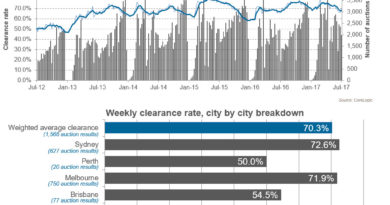Australia’s Commercial Construction Hot-Spots; They Are Not Where You Think They Are.
For many, commercial real estate construction evokes images of large, glass cityscapes with cranes sticking up throughout. This vision is furthered by the narrative that, in the wake of a mining and manufacturing bust, the future of Australia’s workforce is in service and knowledge sectors.
One might also expect the most attractive place to build commercial real estate is in the heart of a CBD. In urban economics, it is thought that businesses locating within proximity to many other firms benefit from lower production costs, lower freight costs and higher networking opportunities.
Yet looking at the top 10 postcodes for commercial construction activity in the last 12 months, the reality of commercial construction in Australia could not be further from this scene.
Top 10 postcodes for commercial construction activity over the year reveals activity is strongest around the fringes of the Melbourne metropolitan, two south-east Queensland regions, and, perhaps most surprisingly, a postcode in the Pilbara region.
Top 10 Postcodes for Commercial Construction, Year to March 2017
- 3175 (Dandenong East, Dandenong North, Dandenong South) – 23 Projects
- 4350 (Toowoomba East, Toowoomba South, Toowoomba West, Toowoomba Village Fair) – 21 Projects
- 3173 (Keysborough) – 16 Projects
- 6714 (Balla Balla, Cooya Pooya, Gnoorea, Karratha, Mardie) – 14 Projects
- 3030 (Werribee, Werribee South) – 13 Projects
- 3061 (Campbellfield) – 12 Projects
- 3810 (Pakenham, Pakenham Upper, Pakenham South) – 12 Projects
- 3201 (Carrum Downs) – 12 Projects
- 3076 (Epping) – 11 Projects
- 4573 (Coolum Beach, Marcus Beach, Mount Coolum, Peregian Beach, Peregian Springs) – 11 Projects
Topping the list was postcode 3175 – the Dandenong region – in the south-east of the Melbourne Metropolitan.
There were 23 commercial construction starts in this postcode, and all were classified as industrial. Of the seven Victorian postcodes featured in this list, 89% of the projects that commenced were industrial.
ABS data suggests the number of Victorians employed in manufacturing declined 8.5% over the last five years. As Holden winds down Australian operations this year, another 1,300 manufacturing jobs are expected to be lost. Given the decline of work typically housed in industrial buildings, where does the underlying demand for industrial construction come from?
Industrial real estate has many uses. Inventory storage and distribution centres will be of increased importance as Amazon sets up retail offerings in Australia. The greater Melbourne metropolitan is a prime position for retail warehousing in particular, due to strong household demand, and being positioned near Tasmania and the ACT, where household consumption accelerated 2.43% and 2.29% respectively over 2016.
Furthermore, there are localised opportunities to take advantage of rising export demand, particularly from emerging middle classes in the Asia Pacific. The 12 month average export value from Victoria lifted 12% in the last five years, and 60% of that uplift was from China. According to Trade Victoria, the state is the largest supplier of food and fibre products to China.
With the OECD expecting the Asia Pacific to account for over 60% of the world’s middle class by 2030, demand for premium food in the region will rise. Food processing and storage facilities will likely retain demand, particularly in established industrial hubs like the Dandenong region. Industrial real estate is relatively cheap to establish on the fringe of the Melbourne Metropolitan.
The postcode with the second highest number of commercial construction starts, at 21 projects over the year, was even further afield in postcode 4350 – consisting of the wider Toowoomba region in Queensland. The Toowoomba region saw 13 industrial starts, a couple of retail and office spaces, and accommodation related construction. These diverse construction starts signal Toowoomba as an emerging, regional economic growth hub due to its investment in a diverse employment base.
Number ten on the list is also a Queensland postcode, just north of the Sunshine Coast CBD. In the year to March, the region has seen commencement of $30 million worth of commercial real estate, including a $3 million technology hub precinct which is aimed at attracting digital businesses and supporting local technology start-ups.
Perhaps most surprising is the fourth highest postcode for commercial construction starts – 6714, in the City of Karratha. Between a new arts and theatre precinct, food retailers and warehouse builds, the City of Karratha saw nearly $70 million in construction commence in the year to March. $60 million of this was in government owned projects, suggesting construction is being driven by the efforts of local government to diversify employment in the region. New proposals for retail have been scrutinised by locals, who are sceptical of whether market conditions warrant this investment.
Interestingly, commercial construction will likely shift again over 2017, with potential office shortages being forecast in the Sydney CBD. The Property Council of Australia reported the Sydney CBD had the tightest vacancy rate of 6.2% in January 2017.
Eliza Owen
Commercial Research Analyst
Subscribe to the free Commercial Pulse eNewsletter
Get the latest commercial news and sales data each week from our CoreLogic Commercial Pulse! Click here to subscribe
Source: CoreLogic Feed



